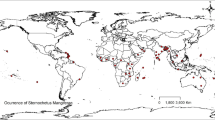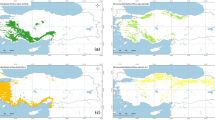Abstract
The maximum entropy (MaxEnt) algorithm was used to predict the potential geographic distribution of the mango stone weevil (MSW), Sternochetus mangiferae, because of its quarantine importance. Projections were made based on the relation between MSW presence data as well as current and projected climate data for the study region. The MaxEnt simulation results give an accurate estimation of the species' range in terms of bias of appropriate and inappropriate regions for its incidence adaptability in the present and projected climatic scenarios. The ecological niche model gives an excellent fit for MSW distribution with a high value of area under the curve (AUC) of 0.900. The jackknife test showed that the most important bioclimatic variable in determining the distribution of MSW is the mean diurnal range. South Asia (India, Myanmar, Bangladesh, Vietnam, Thailand), Australia, and Africa (Tanzania) were predicted to have high suitability areas for MSW distribution. In India, the model predicted higher pest suitability areas in Andhra Pradesh, Orissa's coastal regions, West Bengal's southern parts, and parts of Kerala and Karnataka. Projections of future climate scenarios reveal a relative increase in S. mangiferae distribution. The study identified high-suitability regions around the world, along with India, for the potential establishment of MSW. It advises developing biosecurity/quarantine measures to prevent it from expanding to new areas.










Similar content being viewed by others
References
Anderson RP (2013) A framework for using niche models to estimate the impacts of climate change on species distributions. Ann New York Acad Sci 1297(1):8–28. https://doi.org/10.1111/nyas.12264
Bagle BG, Prasad VG (1984) Studies on varietal incidence and control of stone weevil, S. mangiferae (F.) (Coleoptera: Curculionidae). Ind J Ent 47(3):262–264
Baradevanal G, Shukla PK, Rajan S (2020) Predicting the potential distribution of geographically-limited species, Apsylla cistellata Buckton (Psyllidae: Hemiptera) on mango (Mangifera indica) under different climate change scenarios. Int J Trop Insect Sci. https://doi.org/10.1007/s42690-020-00198-5
Bellard C, Bertelsmeier C, Leadley P, Thuiller W, Courchamp F (2012) Impacts of climate change on the future of biodiversity. Ecol Lett 15(4):365–377. https://doi.org/10.1111/j.1461-0248.2011.01736.x
CABI (2020) Datasheet on Sternochetus mangiferae (mango seed weevil). https://www.cabi.org/isc/datasheet/16434#244DF05B-48E1-4884-8C74-BE1AB9E4F294. (Accessed on 01.12.2020)
Choudhary JS, Mali SS, Fand BB, Das B (2019) Predicting the invasion potential of indigenous restricted mango fruit borer, Citripestis eutraphera (Lepidoptera: Pyralidae) in India based on MaxEnt modelling. Curr Sci 116(4):636. https://doi.org/10.18520/cs/v116/i4/636-642
Cunningham I (1989) Pests: Insects. In: Bagshaw J (ed) Mango pests and disorders. Information Series QI89007.
Cunningham I (1991) Mango seed weevil in Queensland. Acta Hort 291:413–417
De K, Pande YD (1988) Bionomics and some behavioural aspects of the mango stone weevil, Sternochetus gravis (Fabricius) (Coleoptera: Curculionidae). Entomon 1317–24
Dey K, Pande YD (1987) Evaluation of certain non-insecticidal methods of reducing infestation of the mango nut weevil, Sternochetus gravis (F.) in India. Trop Pest Manag 33:27–28
Edvardsen A, Bakkestuen V, Halvorsen R (2011) A fine-grained spatial prediction model for the red-listed vascular plant Scorzonera humilis. Nord J Bot 29(4):495–504. https://doi.org/10.1111/j.1756-1051.2010.00984.x
Elith J, Leathwick JR (2009) Species Distribution Models: Ecological Explanation and Prediction Across Space and Time. Annu Rev Ecol Evol Syst 40(1):677–697. https://doi.org/10.1146/annurev.ecolsys.110308.120159
Elith J, Phillips SJ, Hastie T, Dudík M, Chee YE, Yates CJ (2011) A statistical explanation of MaxEnt for ecologists. Divers Distrib 17(1):43–57. https://doi.org/10.1111/j.1472-4642.2010.00725
Elith JH, Graham CP, Anderson R, Dudík M, Ferrier S, Guisan A et al (2006) Novel methods improve prediction of species distributions from occurrence data. Ecography 29:129–151. https://doi.org/10.1111/j.2006.0906-7590.04596.x
Euatrakool O, Rujitharanawong A, Chukumnerd S, Rattanadechakul W, Phodee A, Chaowalit S, Bannakan I (2015) Detection survey of mango seed weevil: Sternochetus mangiferae (Fabricius)(Coleoptera: Curculionidae) in Thailand (online) (https://www.ippc.int/static/media/files/eventreporting/2015/04/20/Detection_Survey_of_Mango_Seed__Weevil_from_pdf_Entozoo_journal_APDokyM.pdf). Accessed 3 Apr 2023
Feng X, Papeş M (2015) Ecological niche modelling confirms potential north-east range expansion of the nine-banded armadillo (Dasypus novemcinctus) in the USA. J Biogeogr 42:803–807. https://doi.org/10.1111/jbi.12427
Follett PA, Gabbard Z (2000) Effect of mango weevil (Coleoptera: Curculionidae) damage on mango seed viability in Hawaii. J Econ Entomol 93:1237–1240. https://doi.org/10.1603/0022-0493-93.4.1237
Follett PA (2001) Irradiation as a quarantine treatment for mango seed weevil. In Proceedings Hawaiian Entomological Society 35: 85–90
Galdino TVS, Kumar S, Oliveira LSS, Alfenas AC, Neven LG, Al-Sadi AM, Picanço MC (2016) Mapping Global Potential Risk of Mango Sudden Decline Disease Caused by Ceratocystis fimbriata. PLoS One 11(7):e0159450. https://doi.org/10.1371/journal.pone.0159450
Guisan A, Zimmermann NE (2000) Predictive habitat distribution models in ecology. Ecol Modell 135:147–186. https://doi.org/10.1016/S0304-3800(00)00354-9
Halvorsen R, Mazzoni S, Bryn A, Bakkestuen V (2015) Opportunities for improved distribution modeling practice via a strict maximum likelihood interpretation of MaxEnt. Ecography 38(2):172–183. https://doi.org/10.1111/ecog.00565
Hernandez PA, Graham CH, Master LL, Albert DL (2006) The effect of sample size and species characteristics on performance of different species distribution modelling methods. Ecography 29:773–785
IPCC Climate Change (2014) Synthesis Report Core Writing Team, Pachauri RK, Meyer LA (eds) Contribution of Working Groups I, II and III to the Fifth Assessment Report of the Intergovernmental Panel on Climate Change, IPCC, Geneva, Switzerland, p 151
Jarnevich CS, Stohlgren TJ, Kumar S, Morisette JT, Holcombe TR (2015) Caveats for correlative species distribution modeling. Ecol Inform 29(1):6–15. https://doi.org/10.1016/j.ecoinf.2015.06.007
Jiménez-Valverde A, Peterson AT, Soberón J, Overton JM, Aragón P, Lobo JM (2011) Use of niche models in invasive species risk assessments. Biol Invasions 13(12):2785–2797. https://doi.org/10.1007/s10530-011-9963-4
Jing W, Qi GJ, Jun MA, Ren Y, Wang R, Simon M (2020) Predicting the potential geographic distribution of Bactrocera bryoniae and Bactrocera neohumeralis (Diptera: Tephritidae) in China using MaxEnt ecological niche modeling. J Integr Agric 19(8):2072–2082. https://doi.org/10.1016/s2095-3119(19)62840-6
Kumar S, LeBrun EG, Stohlgren TJ, Stabach JA, McDonald DL, Oi DH, LaPolla JS (2015) Evidence of niche shift and global invasion potential of the Tawny Crazy ant. Nylanderia Fulva Ecol Evol 5(20):4628–4641. https://doi.org/10.1002/ece3.1737
Kumar S, Neven LG, Yee WL (2014) Evaluating correlative and mechanistic niche models for assessing the risk of pest establishment. Ecosphere 5(7):art86. https://doi.org/10.1890/es14-00050.1
Kumar S, Yee WL, Neven LG (2016) Mapping Global Potential Risk of Establishment of Rhagoletis pomonella (Diptera: Tephritidae) Using MaxEnt and CLIMEX Niche Models. J Econ Entomol 109(5):2043–2053. https://doi.org/10.1093/jee/tow166
Pearson RG, Thuiller W, Araújo MB, Martinez-Meyer E, Brotons L, McClean C, Miles L, Segurado P, Dawson TP, Lees DC (2006) Model-based uncertainty in species range prediction. J Biogeogr 33:1704–1711. https://doi.org/10.1111/j.1365-2699.2006.01460.x
Pearson RG, Raxworthy CJ, Nakamura M, Peterson AT (2007) Predicting species distributions from small numbers of occurrence records: a test case using cryptic geckos in Madagascar. J Biogeogr 34(1):102–117. https://doi.org/10.1111/j.1365-2699.2006.01594
Peña JE, Mohyuddin AI (1997) Insect pests. In: Litz RE (ed) The mango: botany, production and uses. CAB International, Wallingford, p 327
Peña JE, Mohyuddin AI, Wysoki M (1998) A review of the pest management situation in mango agroecosystems. Phytoparasitica 26:1–20
Peterson AT (2011) Ecological niche conservatism: A time-structured review of evidence. J Biogeogr 38(5):817–827. https://doi.org/10.1111/j.1365-2699.2010.02456.x
Peterson AT, Bauer JT, Mills JN (2004) Ecologic and geographic distribution of filovirus disease. Emerg Infect Dis 10(1):40. https://doi.org/10.3201/eid1001.030125
Phillips SJ, Anderson RP, Schapire RE (2006) Maximum entropy modeling of species geographic distributions. Ecol Modell 190(3–4):231–259. https://doi.org/10.1016/j.ecolmodel.2005.03.026
Phillips SJ, Dudík M (2008) Modeling of species distributions with Maxent: new extensions and a comprehensive evaluation. Ecography 31(2):161–175. https://doi.org/10.1111/j.0906-7590.2008.5203.x
Pinese B, Holmes R (2005) Managing mango seed weevil. Horticulture and Forestry Science (online). http://www.dpi.qld.gov.au
Shukla PK, Baradevanal G, Rajan S, Fatima T (2020) MaxEnt prediction for potential risk of mango wilt caused by Ceratocystis fimbriata Ellis and Halst under different climate change scenarios in India. J Plant Pathol 102:765–773. https://doi.org/10.1007/s42161-020-00502-9
Shukla RP, Tandon PL (1985) Bio-ecology and management of the mango weevil, Sternochetus mangiferae (Fabricius) (Coleoptera: Curculionidae). Int J Trop Agric 3:293–303
Smith ESC (1996) Mango seed weevil. Department of Primary Industries, NorthernTerritory. Agnote No 110
Srivastava RP (1997) Mango insect pest management. International Book Distributing Co., Lucknow
Thuiller W (2004) Patterns and uncertainties of species’ range shifts under climate change. Glob Chang Biol 10:2020–2027. https://doi.org/10.1111/j.1365-2486.2004.00859.x
van Zonneveld M, Jarvis A, Dvorak W, Lema G, Leibing C (2009) Climate change impact predictions on Pinus patula and Pinus tecunumanii populations in Mexico and Central America. Forest Ecol Manag 257:1566–1576. https://doi.org/10.1016/j.foreco.2008.12.027
Verghese A (2000) Recent studies on the management of mango stone weevil Sternochaetus mangiferae (Fab.). (Coleoptera: Curculionidae) in South India. Acta Hort 509:19–22
Acknowledgements
The authors are thankful to the Director, IARI, New Delhi, for providing facilities to carry out the work. The authors thank Dr. Abraham Verghese, Former Director ICAR-National Bureau of Agricultural Insect Resources (NBAIR), Bangalore (India), for the critical comments and suggestions for the improvement of the manuscript. Thanks, are also due to the Indian Council of Agricultural Research, New Delhi, for ICAR- Postdoctoral fellowship for lead author.
Author information
Authors and Affiliations
Corresponding author
Ethics declarations
Conflict of interests
The authors declare that they have no conflict of interest.
Human and animal rights and informed consent
This research not involved any human participants, their data or biological material.
Additional information
Publisher's note
Springer Nature remains neutral with regard to jurisdictional claims in published maps and institutional affiliations.
Rights and permissions
Springer Nature or its licensor (e.g. a society or other partner) holds exclusive rights to this article under a publishing agreement with the author(s) or other rightsholder(s); author self-archiving of the accepted manuscript version of this article is solely governed by the terms of such publishing agreement and applicable law.
About this article
Cite this article
Baradevanal, G., Chander, S., Singh, H.S. et al. Mapping the risk of quarantine pest Sternochetus mangiferae under different climate change scenarios through species distribution modelling. Int J Trop Insect Sci 43, 919–932 (2023). https://doi.org/10.1007/s42690-023-01000-y
Received:
Accepted:
Published:
Issue Date:
DOI: https://doi.org/10.1007/s42690-023-01000-y




